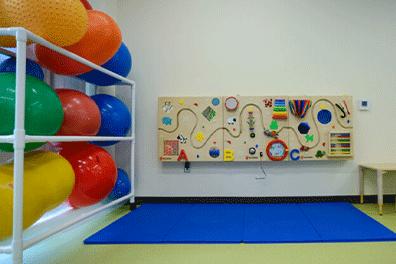Overview
What is pediatric physical therapy (PT)?

Physical therapy (PT) is a planned program of activities that will help improve your child’s movement or pain.
A licensed physical therapist examines your child and plans treatment based on your doctor’s request and the therapist’s evaluation of your child’s needs.
Benefits
Why does my child need pediatric physical therapy (PT)?
Our patients who are being treated as inpatients may need physical therapy to help them regain movement skills or prepare for a return home. We also provide outpatient physical therapy to children who have a number of conditions and chronic diseases within one of our seven locations across the metroplex.
For example, your child with cerebral palsy (CP) might need physical therapy throughout their life to improve muscle strength and movement, and to prevent joints from stiffening. Physical therapy is the main treatment for torticollis, tightening of an infant’s neck muscles that can lead to problems with movement, balance or your child’s skeletal development.
Examples of other conditions in children and adolescents that might require physical therapy include:
Amputations
Bone tumors
Congenital (present at birth) differences in limb length
Orthopedic injuries
Problems with gait
Problems with visual, motor or perceptual development
Side Effects
What are the benefits of pediatric physical therapy (PT)?
If your child or adolescent is injured or has problems with movement because of a disability or chronic illness, your doctor may recommend physical therapy. The purpose of physical therapy is to maintain or restore movement or range of motion, to help ease pain and help patients prevent injuries. Sometimes, physical therapy can replace surgery or medication in treating a problem.
Risks
What happens at my child's first pediatric physical therapy (PT) appointment?
At the first visit (evaluation), be prepared to answer plenty of questions about your child’s health or support your adolescent’s interview with answers about family medical history. The physical therapist will thoroughly evaluate your child during the first visit, and may ask your child to perform certain activities to observe how the body functions and moves or to measure muscle strength. For example, the therapist might have your child walk across the room.
The therapist may start your child on a program right away. The therapist develops a series of movements or activities and provides education to you and your child. The program might include regular exercises or activities to perform at home between visits with the therapist.